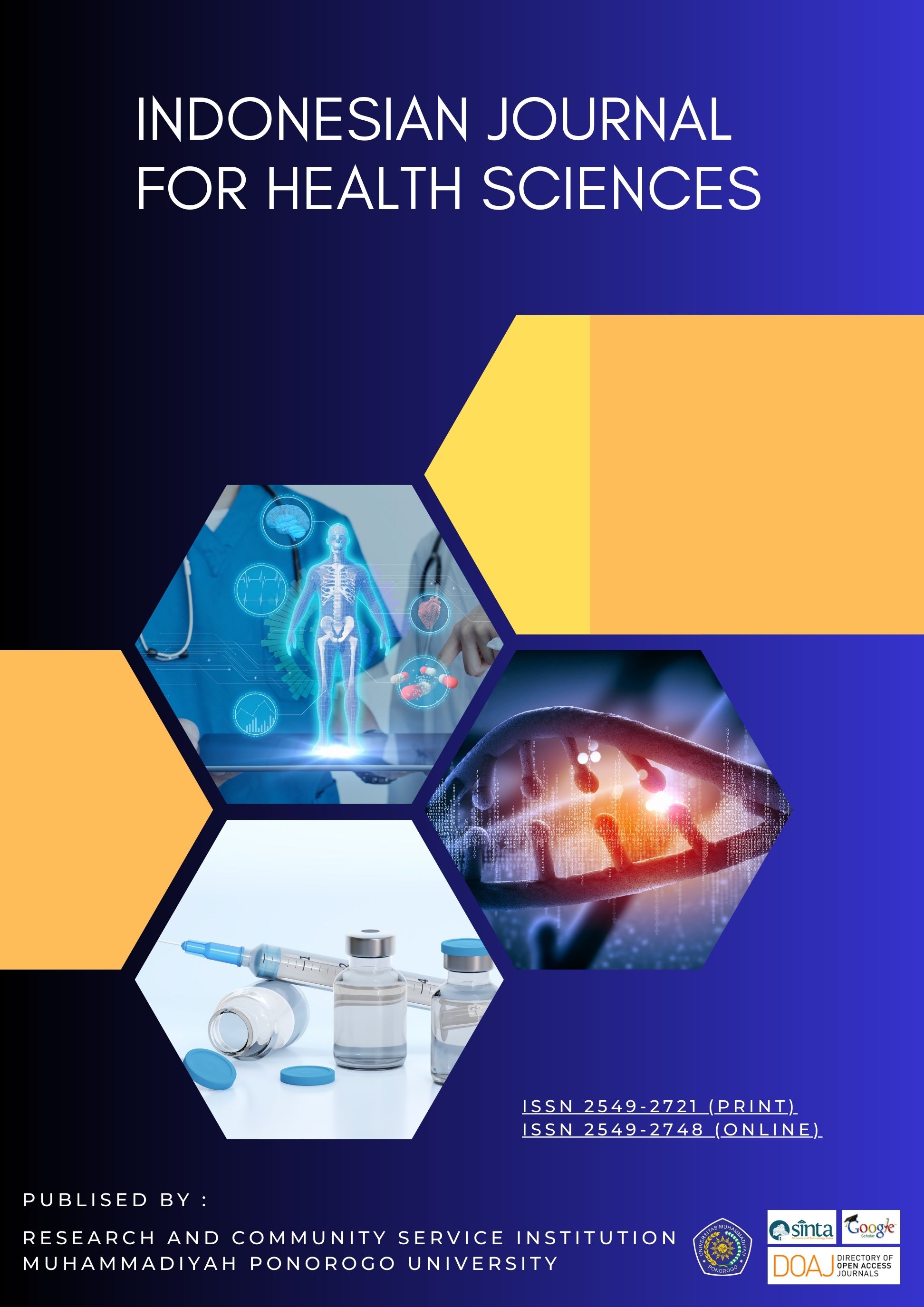Survey peningkatan resiko penyakit DM di masa Pandemi covid-19 Di wilayah Kabupaten Ponorogo tahun 2021
DOI:
https://doi.org/10.24269/ijhs.v7i1.5158Abstract
DM is a chronic disease that cannot be cured but can only be reduced and blood sugar levels controlled. Blood sugar levels of DM patients can be controlled and reduced by pharmacological and non-pharmacological measures. The impact of the Covid 19 pandemic that can increase the risk of DM is stress. Stress due to the declining level of the community's economy can be due to losing a job, increasing the burden of living and others. At times of stress can increase levels of the hormone cortisol which can increase blood sugar levels. During the pandemic, people are afraid to leave the house so that activity decreases so that it will reduce the use of blood sugar by cells so that blood sugar increases
The method used in this research is a survey by distributing a google form questionnaire with the link https://forms.gle/EsCR4qnoj62LZFnv9 via WA Online media to the community in the Ponorogo district from 6-15 October 2021 so that the number of respondents who fit the sample criteria is as much as 122 respondents. Measurement of DM risk factors using the FINDRISC questionnaire is a questionnaire that helps to identify the risk of DM disease.
The results of the Survey on Increasing the Risk of DM Disease During the Covid 19 Pandemic in the Ponorogo Regency Region in 2021 it is known that from 122 respondents, 60 (49%) low risk respondents, 45 (36%) risk respondents slightly increased, 8 (7%) risk respondents medium, 8 (7%) high risk respondents and 1 (1%) very high risk respondents.
References
[2] Anglia Ruskin University, 2007. Harvard Sytem of Referencing Guide. Anglia Ruskin University
[3] Arikunto, S, 2010. Prosedur Penelitian Suatu pendekatan praktik. Jakarta: Rineka Cipta.
[4] Azwar, S, 2005. Metode Penelitian. Yogyakarta: Pustaka Pelajar Offset
[5] Balcia, 1999. Shoulder Adhesive Capsulitis and Shoulder Range of Motion in Type II Diabetes Mellitus . http//www.pubmed – indexed for Medline. Diakses tanggal 10 Januari 2011
[6] Budiarto, E, 2002. Biostatistika Untuk Kedokteran dan Kesehatan masyarakat. Jakarta: EGC
[7] Candra, B, 1995. Pengantar Statistik Kesehatan. Jakarta: EGC
[8] Christensen and Kenney, 2009, Proses Keperawatan Aplikasi Model Konseptual, alih bahasa dari judul aslinya Nursing Process : Aplication of Conceptual Models, Jakarta, EGC
[9] Ganong, 2002. Buku Ajar Fisiologi Kedokteran. Alih bahasa DjauhariWidjajakusumah dari judul aslinya Review of Medical Physiology. Jakarta: EGC
[10] George, J, 1990. Nursing Theories The Base for Profesional Nursing Practice. Prentice Hall International Limited: London
[11] Goldsmith, 2002. The Effects of Range of Motion on Plantar Pressure of Patients with Diabetes Mellitus. http//www.pubmed – indexed for Medline. Diakses tanggal 10 Januari 2011.
[12] Greenspan and Baxter, 2000. Endokrinologi Dasar dan Klinik. Alih bahasa Caroline Wijaya dkk dari judul aslinya Basic and Clinikal Endokrinologi. Jakarta: EGC
[13] Guyton, 2008. Buku Ajar Fisiologi Kedokteran. Alih bahasa Tengadi dkk dari judul aslinya Textbook of Medical Physiologi. Jakarta. EGC
[14] Harris and Taylor, 2008. Medical Statistiks Made Easy. Malta: Gutenberg press
[15] Kapit, et all, 1987. The Physiology Coloring Book. New York: Harper Collins Publisher
[16] Kuntoro, 2007. Metode Statistik. Pustaka Melati: Surabaya
[17] Kuntoro, 2008. Metode Sampling dan Penentuan Besar Sampel . Pustaka Melati: Surabaya
[18] Kuntoro, 2009. Dasar Filosofis Metodologi Penelitian . Pustaka Melati: Surabaya
[19] Laaksonen, et all, 2005. Physical Aktivity in the Prevention of Type 2 Diabetes. Kuopio: Finland, Vol. 54, pp. 158 – 165.
[20] Lindsay and Bennet, 2001. Type 2 Diabetes The Thrifty Phenotype – an Overview. Medical Bulletin. British Arizoma USA: Phoenix. Vol.60. pp.21 – 32.
[21] Long Barbara, 1996. Perawatan Medikal Bedah, alih bahasa Yayasan Ikatan Alumni Pendidikan Keperawatan Bandung, dari judul aslinya Medical Surgical. Bandung: YIAPK
[22] Mansjoer dkk, 2000. Kapita Selekta Kedokteran Edisi III Jilid 2. Jakarta : Media Aesculapius
[23] Mogensen, et all, 2007. MitochonDrial Respiration is Decreased in Skeletal Muscle of Patients with Type 2 Diabetes. Odense. Denmark: ahead. Vol. 56, pp. 1592 – 1599.
[24] Murti, B, 1997. Prinsip dan Metode Riset Epidemiologi. Yogyakarta: Gadjah Mada University Press.
[25] Notoatmodjo, S, 2002. Metodologi Penelitian Kesehatan. Jakarta: Rineka Cipta
[26] Pereira, et all, 2008. Insulin Resistance Of Protein Metabolism in Type 2 Diabetes. American Diabetes Association. Vol 57. pp. 56 – 63.
[27] Perkeni, 2006. Konsensus Pengelolaan dan Pencegahan Diabetes Mellitus. Jakarta: Perkeni
[28] Persadia, 2006. VCD Senam Diabetes Seri III . Jakarta: Persadia
[29] Price and Wilson, 2006. Patofisiologi konsep klinis Proses-Proses Penyakit. alih bahasa Peter Anugerah dari judul aslinya Patofisiologi. EGC: Jakarta
[30] Putra, K, 2010. Efek senam DM terhadap gula darah sewaktu dan tekanan darah pada anggota paguyuban diabetes putat jaya dengan DM tipe 2. Jurnal Airlanga University Library: Surabaya
[31] Rao, 2006. Increased Ankle Stiffnes and Reduced Dorsiflexion Range of Motion in Individual with Diabetes Mellitus. Lowa City: Towson. Vol. 27. pp. 617 – 622.
[32] Sediaoetama, 2007. Ilmu Gizi untuk Mahasiswa dan Profesi di Indonesia. Dian rakyat: Jakarta
[33] Shao, et all, 1999. Decreased Insulin Receptor Tyrosin Kinase activity and Plasma Cell Membrane Glycoprotein-1 Overexpression in Skeletal Muscle from Obese Women with Gestational Diabetes Mellitus (GDM). California. San Francisco, Vol. 49, pp. 603 – 610.
[34] Shao, et all, 2001. Phosphatidylinositol 3-Kinase Redistribution is Associated with Skeletal Muscle Insulin Resistance in Gestational Diabetes Mellitus. Colorado. Denver. Vol 51. pp.19 – 29.
[35] Shepherd and Kahn, 1999. Glucose Transporter and Insulin Action. The New England Journal of Medicine: London. Vol. 341. pp. 248 – 257.
[36] Sherwood, 2001. Fisiologi Manusia dari Sel Ke Sistem. alih bahasa Brahm U.Pendit dari judul aslinya Human Physiology From Cells tio System. EGC: Jakarta
[37] Short, et all, 2003. Impact of Aerobik Exercise Training on Age Related Change in Insulin and Muscle Oxidative Capacity. Rochester. Minnesota. Vol. 52. pp.188 -1896.
[38] Soegondo dan Sukardji, 2008. Hidup Secara Mandiri dengan Diabetes Melitus. Jakarta: FKUI
[39] Soegondo, dkk, 2009. Penatalaksanaan Diabetes Melitus Terpadu. Jakarta: FKUI
[40] Soesanto, B, 2008. Biostatistik Penelitian Kesehatan. Surabaya: dua tujuh
[41] Sugiyono, 2007. Statistika untuk Penelitian. Bandung: Alfabeta
[42] Supranto, 2000. Teknik Sampling untuk Survei dan Eksperimen. Jakarta: Rineka Cipta.
[43] Suratun, dkk, 2008. Asuhan Keperawatan Klien Gangguan Sistem Muskuloskeletal. Jakarta. EGC
[44] Suyono, 2001. Buku Ajar Penyakit Dalam jilid II. Edisi 3. Jakarta: Balai Penerbit FKUI
[45] WHO, 2009. Definition, Diagnosis and Classification of Diabetes Mellitus and its Complication. Genewa: Departement of Noncommunicable Disease Surveillance.
[46] Williams, et all, 2001. Interaction of Impaired Glucose Transport and Phosphorylation in in Skeletal Muscle Insulin Resistance. Pittsburgh. Pennsylvania. Vol. 50. pp. 2069 – 2079.
[47] Vandersmissen, G.J & Godderis,L (2015). Evaluation of the Finnish Diabetes Risk Score (FINDRISC) for diabetes screening in occupational health care. Int J Occup Med Environ Health,
Downloads
Additional Files
Published
Issue
Section
License

This work is licensed under a Creative Commons Attribution-ShareAlike 4.0 International License.












